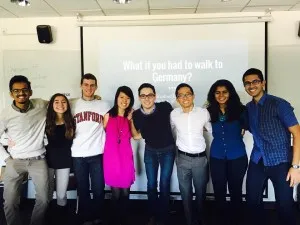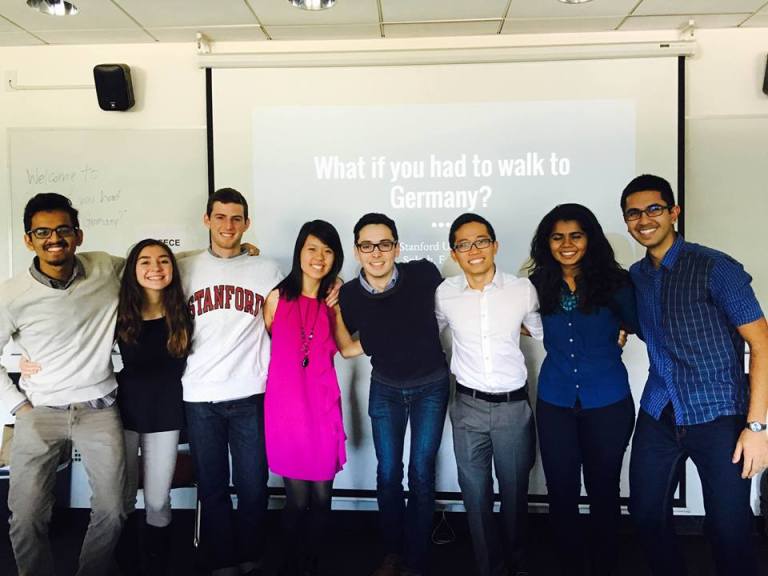
Human trafficking and the refugee crisis may seem far away from life at Stanford, but the International Justice Mission (IJM) and UNICEF Stanford are determined to bring them close to home.
“It’s so hard to remember that we have all these problems in the Bay Area. People always talk about East Palo Alto, and education, which is great, but there are a host of other issues that lurk under the veneer of Silicon Valley entrepreneurship,” said vice president Ashley Kim ’18.
Nearly 300 human trafficking victims were identified in San Francisco in the second half of 2014 alone.
Yet these issues can’t help but feel distant from the manicured green lawns of Stanford and Palo Alto. Jack Seibert ’19 spoke about the big issues that came to mind in San Francisco.
“Homelessness, gentrification I’d say are the big ones,” Seibert said. “I wouldn’t think of human trafficking at all.”
“The thing is, human trafficking is created by demand; the demand comes from us,” Kim added.
Advocacy on global humanitarian issues has had a slow start at Stanford. Kim is one of seven students who make up the core of the International Justice Mission.
Similarly, UNICEF Stanford has had to overhaul their core leadership team just this year after a long stagnation.
“We didn’t really have general meetings before, our past president was a graduating senior so she didn’t have a lot of time,” said Monica Chan ’17, the current president of UNICEF Stanford.
First steps forward
That doesn’t mean the groups aren’t going to try. Already, members are steering the nascent movements towards greater visibility on campus. UNICEF Stanford ran their very first Splash course last Saturday, teaching a room of 20 high school students about the refugee crisis in Syria.
“What’s the most important thing refugees carry with them on the way from Syria?” Albert Feng ’18, co-chair of education for UNICEF Stanford, asked the semi-circle of high school students before him.
Water and travel documentation were the top guesses from the audience.
“Those are also important, but it’s actually cellphones, solar power chargers and outlets,” Feng said. “The refugees use Facebook to check where their friends are, what routes to take, snap a few selfies when they get there. There are lots of smugglers so they’ll need to know who to avoid, how they can run away from them. Needs-wise, they’re not all that different from us.”
To break out of the bubble, it may help to understand the issues in relation to ourselves. A running theme for both groups is the way these humanitarian problems relate to Americans’ own lives.
The International Justice Mission, for one, is starting at home. A screening of the documentary “In Plain Sight” at Kimball Hall last Friday was their first awareness event for the quarter.
“We’re actually more than fine with doing things on campus first because it’s where our target group is,” Kim said. “With human trafficking, awareness of what’s going on around is such a big deal.”
“While we may think, ‘I’m not involved in any of that,’ it’s about which brands we buy our clothes from, whether they’re involved in labour trafficking,” Kim said, also citing child trafficking in the Bay Area as one of her chief concerns. “It’s the pornography we watch.”
Both groups see their role as starting these kinds of conversations and introspection on campus. And the first seeds have been planted. At UNICEF Stanford’s Saturday Splash course, students were beginning to raise the right questions.
“What’s stopping the US government from taking in more refugees?” asked a high school sophomore.
“I feel like [the refugees] can be like us, in a lot of ways, but their situation is really awful now,” another participant said.
New directions
Chan and Kim both entered into their roles with loose ends and shaky foundations left by previous leaders but pushed ahead.
“I just kept interviewing people from outside UNICEF for the core team one-by-one until I had a solid group of people to lead,” Chan said.
Today, Chan and her team run a dual schedule of leadership team meetings and general meetings, where members discuss events and chip in for schoolwide projects, such as Splash.
As for the International Justice Mission, their size belies their ambitions.
“We’re trying to host an art-cum-music-cum-justice event at Kimball on Dec. 4,” Kim said. “We’re trying to get musicians to sign up, set aside time for open mic, and have our information about human trafficking next to poetry and arts stations.”
Beyond advocacy, they’re also planning intensive direct service opportunities with community partners in the Bay Area.
“The bubble is real,” said Suraj Balchand ’18, Co-chair of the Education Committee at UNICEF Stanford. “It can be so easy to get caught up in life here and forget that there are all of these people who need help.”
“So much of international relief efforts and political action begins with individuals who care, and a lot of the time we forget that we can at least take the first step by finding out about the situation,” he added.
Contact Fangzhou Liu at fzliu96 ‘at’ stanford.edu.
This post has been updated. A previous version did not specify that Suraj Balchand is a Co-Chair of the Education Committee at UNICEF Stanford. The Daily regrets this error.
